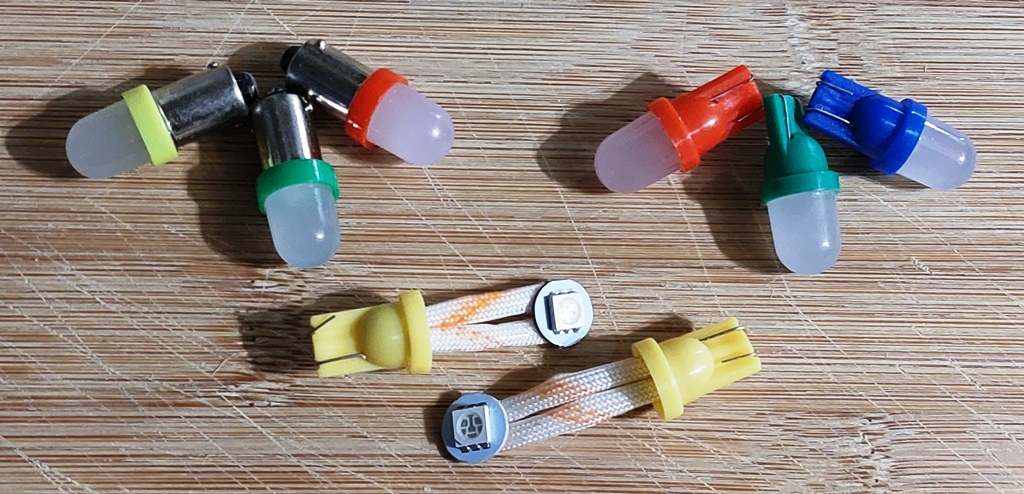Types of lightbulbs used in pinball machines
A lot of people consider a pinball machine to be a large box with blinking lights.. and they're correct :)
The question here is what type of lightbulbs are used.
Especially if you're new to pinball machines, you may wonder what type lamps are in use and where to buy them.
If I can already give one advise: buy the lightbulbs at a dedicated pinball store. They'll have the correct parts in stock
at the best prices. Don't go to a local hardware store, DIY shop or a large shop that sells light fixtures.
They won't know them, and a special order may cost you 10 times the normal price.
 Quick summary: most popular pinball machines with incandescant bulbs use type #44 (bayonet) or #555 (wedge),
and for flasher lamps use types #89 (bayonet) and #906 (wedge). Don't buy them at a general store but at
a specialised pinball parts dealer (aff. link).
Quick summary: most popular pinball machines with incandescant bulbs use type #44 (bayonet) or #555 (wedge),
and for flasher lamps use types #89 (bayonet) and #906 (wedge). Don't buy them at a general store but at
a specialised pinball parts dealer (aff. link).
Different circuits
On most pinball machines there are 2 diffferent types of lamps. General illumination and controlled lighting.
Controlled lights are lights that can go on and off, blink, .. individually. They usually indicate features on the playfield to shoot at, to display a status, ..
General illumination are the lamps that just make the playfield less dark. The pinball machine will not control each lamp separate, but usually the lamps are linked together. The pinball machine will control a group of lamps together. On older machines there was one string for the backbox and one for the playfield. Later the strings split up and could also be dimmed in multiple levels. One such often used separation is: top, center and middle of the playfield. On some games it's different, the left and right part of the playfield are different strings, to create special light effects.
Controlled lights are usually powered by 6.3 DC, and GI by 6.3v AC. The difference between AC and DC only matters if you want to replace incandescant bulbs with leds.
There are always exceptions. Some games use a different type of lightbulb or other voltage. Whitewater uses 12v bulbs in the topper,
which physically look similar to #555 bulbs. Don't confuse them. Creature from the Black Lagoon uses small
bulbs in the ramp.
Pinball2000 machines are also an exception, they don't have GI. Everything is a controlled lamp.
Jersey Jack Pinball uses 12v for GI, Stern games since 2015 use 5v.
Lights and flashers

From left to right: wedge lamp type #555 and flasher #906, bayonet lamp type #44 and flasher #89.
Most old pinball machines only use one type of lamp, a #44 bajonet base of 6.3v.
Some people replaced them with #47 type, which looks similar but draws less current. Unfortunately this
also makes it dimmer.
This change was done to prevent wear from the heat of the lightbulbs. The heat can warp plastics or burn holes.
Old connectors and wiring also don't handle the high current well.
Nowadays installing #47 bulbs isn't necessary anymore, a better solution
is to install led bulbs in older games if you want to save energy and protect the game.
In the 1980ies other lamps started to be used, the #555 wedge type. These are often used where the bulbs can be accessed from the top of the playfield. They are also used where individual lamp holders are replaced by circuit boards, which can hold multiple lamps.
In the second half of the 1980ies pinball manufacturers started to use a different type of lightbulb, controlled by different circuits: flasher lamps.
Flashers are physically much larger than the normal lightbulbs, they're type #89 (bayonet) and #906 (wedge) rated at 12v. They won't light up all the time (they destroy themselves and can even melt nearby plastics if they stay lit for too long) but are used to give a bright flash to draw attention.
That bright flash is achieved by sending a short pulse of higher voltage, up to 20v. This is almost double to what
the lamps are rated at. The pulse is short enough not to damage the flasher lamp but makes it give off a bright light.
Because of this higher voltage involved and the way they are pulsed, the circuits that control flashers have more in
common with the circuits for solenoid coils, than with the circuits that drive regular lamps.
Here also the bajonet type (#89) is mostly used underneath the playfield. The #906 wedge base is mostly found on top of the playfield, on ramps and plastics with a nice plastic cover over it.

Flashers on the playfield usually have such a bright plastic cover over them.
LEDs
Around 2005 leds became available as an aftermarket change in pinball machines. Incandescant lamps could
be replaced by different types of brighter and colored leds. The first years the parts still had to mature.
Only basic types existed and most were very bright. You had to wear sunglasses to play some games.
Later many more types of led were developed which fit better on the playfield.
It took a few years for manufacturers to catch on. Only after 2010 they made the switch from incandescant lamps to leds.
Some manufacturers still used the same logic as before, and just replaced GI circuit bulbs with white leds in the same sockets.
New manufacturers on the market (Spooky, Jersey Jack Pinball, ..) completely changed the circuits that control leds.
This allows them to make use of RGB leds. Instead of only being in a single color, an RGB led is 3 leds in one
(red, green and blue) and is thus able to generate a lot of colors.
The GI of the whole playfield (or part of it) can suddenly turn into another color. Inserts to indicate shots
can now display different colors, giving them a different meaning during gameplay.

Green is good, red is bad, mmkey ?
RGB lightbulbs are usually of a very specific type that's used on that specific manufacturer (or even model of pinball machine). To replace a bad led, you need to find the specific type and an identical replacement.
Replacing incandescant bulbs by leds
As said above, there's now a huge aftermarket business providing leds for when people want to replace the incandescent bulbs. Leds are available in different colors and brightness. Which led exactly to use, mostly depends on the place of the led on the playfield and what effect you want to achieve.

Different types of led lamps.
Many more types exist with more emitting parts, clear (or no) covers, ..
Unfortunately you can't just replace any incandescant lamps with a cheap led that fits physically.
It's more complicated than selecting a nice new color. If a led will work, depends on the type of leds, the pinball machine
and where the original lamp was used for.
Problems that are often encountered are strobing and ghosting.
Very cheap leds may not light at all because of polarity issues.
Leds just work difference from incandescant bulbs. In the latter, a wire will start to glow when electricity goes in it.
More electricity is a brighter (hotter) glow. When the electricity suddenly stops, the wire will still keep on glowing a bit,
it builds up and down gradually.
Leds internally work different and are more instant on/off. When electricity
This information is especially needed when you're not buying pinball leds from a pinball parts shop, but from a general stores like AliExpress. Take notice if there's any mention of 'AC', 'non-ghosting' and 'non-flickering'. Spending a few dollars extra is usually worth it to get quality bulbs. Buying the cheapest you can find can be wasted money if they're not compatible at all with your pinball machines.
Polarity problems
All leds work internally with DC power. If you buy the cheapest leds on the market, they probably can only deal with DC power as input.
You probably know that a battery (which is DC power) has two sides, a positive and negative side.
This is the same for the DC circuit in your pinball machine.
If you insert cheap leds, they may not work at all in one position.
They work when you insert them in the other direction.
That is the polarity part - they work when connected (inserted) in one direction but not in the other.
If you insert this type of led in an AC circuit, they
then be dim compared to when installed on DC, as they only shine for half of the time.
As a minimum, try to buy pinball leds that are marked AC. Don't try to find the cheapest, crappiest led on the market.
With leds from a pinball parts shop (aff.) you're sure
that the parts are made for pinball machines.
Strobing or flickering leds
Most pinball leds are marked 'AC'. They have an internal component that will convert the AC into DC. However they are not perfect, they will also not shine contineously. AC is a sinewave that goes up and down. In the USA it's 60Hz, in Europe it's 50Hz. The led quickly goes out each time the wave passes the center. This can often be seen as flickering : the lamp goes on and off 120 (or 100) times a second.
Non-flickering leds exist: they have an extra internal component that acts like a battery, so the led doesn't dim completely. However they're not the perfect solution. In some games with complicated lightshows they're not sensitive enough.
Strobing is a type of flickering that can occur on certain types of pinball machines. This is caused by how they pinball machine electronics circuit drives the lamps. Electronics don't have an on/off switch that works continuously. They will also quickly pulse the lights on when they have to be lit. GI circuits can be dimmed, this dimming is done by switching the lights to 'off' a certain period of time (milliseconds). With controlled lamps in a matrix, the pinball machine will also very quickly tell each lamp to be 'on'. The combination of at what speed the pinball machine does this and how sensitive the leds are may also cause flickering.
Classic electronic Bally / Stern games (1977-1985) have a similar hardware flickering issue. Because leds draw a lot less current than regular bulbs, the electronics that drive the controlled leds are confused and cause flickering.
Ghosting leds
Ghosting is when leds will not go out completely. They stay dimly lit when they're supposed to be completely off. It usually happens when you replace controlled lamps (machines after 1985) with leds.
Incandescant bulbs need a certain voltage before they will start to light up. Leds are more sensitive and will start to
very dimly light up when they receive a much lower voltage. That's what you are seeing.
Some controlled circuits don't go completely to 0 volts when they go out, there is some rest (ghost) voltage still in the circuit that is high enough
to make leds shine a bit. If your game has it and how much it's visible, depends on the hardware but sometimes also on the software.
On some machines you can fix ghosting issues with a new eprom.
Anti ghosting leds exist. They often work but can have other effects. Some machines use special lightshows and dim the lights a bit during gameplay, some leds don't handle this so you will loose part of the lightshow.
